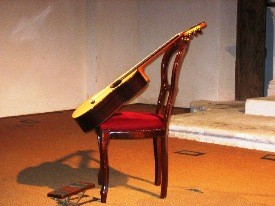35,310 views
SUBSCRIBEEMBEDREPORT
00
This is a beautiful arrangement by Marco Pereira of a great work by "CANHOTO" the famous brazilian guitarist who was contemporary of Augustin Barrios.
Américo Jacomino was born in São Paulo, Brazil. This left-handed guitarist/composer, popularly known as "Canhoto" (left-handed one), was one of the musicians responsible for the “ennoblement” of the guitar in Brazil, once considered an instrument of minor importance. He first performed in Ribeirão Preto in 1907, later earning fame and prestige in concerts and competitions. He was also a guitar pedagogue, and composed not only for the guitar, but for piano and orchestra. In September of 1916 he had his first big concert for a large audience at the Music Conservatory of São Paulo. The importance of this concert has been compared to the concerts of Agustín Barrios and Josefina Robledo (Spanish guitarist, student of Tárrega).
It is through this concert that Américo Jacomino charmed the cultural elite of São Paulo, dissolving the prejudice that had always hindered the development of music for guitar. In 1918 came his first great success: “Nhá Maruca foi s’embora”. More success came in December of 1919 at a concert in the music theater of Rio de Janeiro. In 1922 came another success: "Sad Carnival" in partnership with Real Arlindo. But his biggest success (one of the biggest in Brazil) came in 1925 with the famous waltz "Abismo de Rosas", composed it in 1905 when he was only 16 years old. It was born of of disillusionment after being ignored by a girl whom he adored. In 1927 he presented two programs called "Brazilian Nights", one in the theater Boa Vista and another one in the Municipal theatre of São Paulo. Another successful piece was his "Turunas of the Mauricéia", for 4 guitars, flute, saxofone, two cavaquinhos, maracaxá (bamboo scraper) and pandeiro (tambourine).
Américo Jacomino was born in São Paulo, Brazil. This left-handed guitarist/composer, popularly known as "Canhoto" (left-handed one), was one of the musicians responsible for the “ennoblement” of the guitar in Brazil, once considered an instrument of minor importance. He first performed in Ribeirão Preto in 1907, later earning fame and prestige in concerts and competitions. He was also a guitar pedagogue, and composed not only for the guitar, but for piano and orchestra. In September of 1916 he had his first big concert for a large audience at the Music Conservatory of São Paulo. The importance of this concert has been compared to the concerts of Agustín Barrios and Josefina Robledo (Spanish guitarist, student of Tárrega).
It is through this concert that Américo Jacomino charmed the cultural elite of São Paulo, dissolving the prejudice that had always hindered the development of music for guitar. In 1918 came his first great success: “Nhá Maruca foi s’embora”. More success came in December of 1919 at a concert in the music theater of Rio de Janeiro. In 1922 came another success: "Sad Carnival" in partnership with Real Arlindo. But his biggest success (one of the biggest in Brazil) came in 1925 with the famous waltz "Abismo de Rosas", composed it in 1905 when he was only 16 years old. It was born of of disillusionment after being ignored by a girl whom he adored. In 1927 he presented two programs called "Brazilian Nights", one in the theater Boa Vista and another one in the Municipal theatre of São Paulo. Another successful piece was his "Turunas of the Mauricéia", for 4 guitars, flute, saxofone, two cavaquinhos, maracaxá (bamboo scraper) and pandeiro (tambourine).

Guest comment
Comment too short or empty!
Enter your name, minimum 3 characters long!
0 Comment
Related suggestions
Show More








